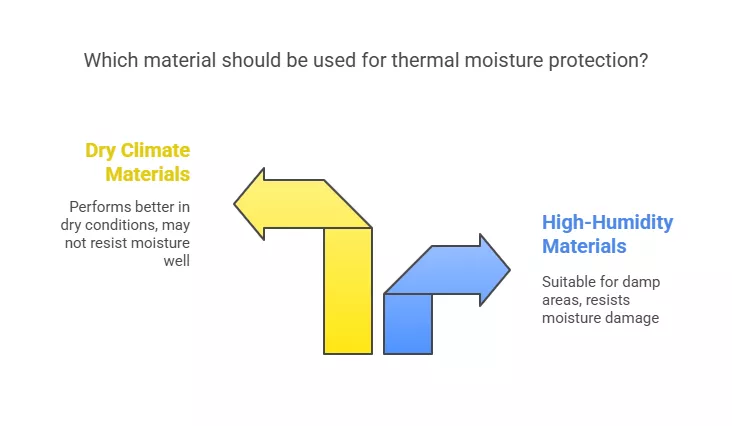Ranked #1 in Accurate and Reliable Estimation Services
A Fastest Turnaround 24 Hours!
Ranked #1 in Accurate and Reliable Estimation Services
A Fastest Turnaround 24 Hours!
Ranked #1 in Accurate and Reliable Estimation Services
A Fastest Turnaround 24 Hours!
Ranked #1 in Accurate and Reliable Estimation Services
A Fastest Turnaround 24 Hours!

Thermal moisture protection plays an important role in construction when it comes to managing water damage and ensuring the energy efficiency of structures. Every construction project requires planning of materials, resources, and costs, and thermal moisture protection is no exception. Numerous errors can occur during planning which can cause an increase in costs, delays for subsequent projects, or even total project failure. In this article, we take a close look at the top seven mistakes to avoid in estimating thermal moisture protection. A small change to provide the correct estimation can save you from making common mistakes.
Regarding thermal moisture protection, there are many different materials such as thermal insulation, vapor barrier shields, and waterproofing membranes. Every material has unique properties that affect the efficiency, the life-cycle, and the pricing.
Mistake to Avoid: A common mistake is not fully understanding the materials you are using. For example, not all materials work the same way in different environments. Some materials may be better suited for high-humidity areas, while others work better in dry climates.
How to Avoid It: Take the time to research and understand the different materials available for your project. Learn about the specific qualities of each material and how they will perform in your climate. For example, if you’re working in a damp area, consider using materials that resist moisture damage, such as fiberglass insulation or vapor barriers designed for wet conditions. Read a detailed article about A Comprehensive Guide to Thermal Moisture Protection Estimating .

Environmental factors play a huge role in the performance of thermal moisture protection systems. Temperature changes, humidity levels, and local weather patterns can all affect how well a system works over time.
Mistake to Avoid: If you don’t consider the climate and environmental conditions of your project site, you could end up using materials that don’t perform as expected. For example, a material that works well in cold climates might not work well in warmer or more humid climates.
How to Avoid It: Before estimating your thermal moisture protection needs, gather data on the local climate and weather patterns. Use this information to select materials that are designed to work in those specific conditions. For example, if the area is subject to heavy rain, you may need to choose moisture-resistant insulation or a waterproof membrane to prevent water damage.
How thermal moisture protection materials are installed is just as important as the materials themselves. The right installation method ensures that the system works effectively and lasts for years.
Mistake to Avoid: Underestimating the complexity of installation can lead to errors in your estimate. For example, some materials may require special equipment or additional labor to install properly, which can increase the cost of the project.
How to Avoid It: When preparing your estimate, be sure to factor in the labor and tools required for installation. Talk to your team or contractors to understand the complexity of the installation process. This includes accounting for things like the need for special equipment, additional workers, or extra time to install the system correctly.
Thermal moisture protection is a long-term investment, and it’s important to consider not just the initial cost, but also the ongoing maintenance and durability of the system. Materials and systems may degrade over time, requiring maintenance or replacement.
Mistake to Avoid: Many estimates focus only on the initial cost of materials and installation, forgetting to include long-term costs. This can lead to surprises down the road when repairs or replacements are needed.
How to Avoid It: When preparing your estimate, include the expected maintenance and replacement costs for the thermal moisture protection system over its lifetime. Choose materials that are durable and easy to maintain, even if they cost a little more upfront. For example, a high-quality vapor barrier may cost more initially but can save you money in the long run by reducing the need for repairs.
Building codes and regulations are in place to ensure that construction projects meet safety and quality standards. When estimating thermal moisture protection, it’s crucial to ensure your system complies with local building codes.
Mistake to Avoid: If you fail to follow local codes and regulations, you might face costly delays or rework. For example, if your protection system doesn’t meet energy efficiency requirements, you may need to make changes after the project has started.
How to Avoid It: Before making your estimate, familiarize yourself with the local building codes related to thermal moisture protection. Ensure that your chosen materials and installation methods meet these regulations. If you’re unsure, consult with a building inspector or an experienced contractor to confirm compliance.
Estimating thermal moisture protection isn’t just about calculating the materials; it’s also about understanding the full scope of the project. This includes all surfaces and areas that need protection, such as walls, roofs, and floors.
Mistake to Avoid: Underestimating the area that needs thermal moisture protection is a common mistake. If you miss certain areas, you may end up with a shortage of materials, which can delay the project and increase costs.
How to Avoid It: Make sure to carefully measure and assess the entire building, including any unique features that may require extra protection, such as windows, doors, or irregular surfaces. It’s always a good idea to walk through the site with your team or an architect to ensure you’ve accounted for every area that needs coverage.
Accurate measurements are essential when estimating the amount of material needed for thermal moisture protection. If you measure inaccurately, you could end up with too much or too little material, both of which can lead to problems.
Mistake to Avoid: Using rough estimates or inaccurate surface area calculations can lead to wasted materials or material shortages. This can increase costs and cause delays.
How to Avoid It: Use precise measurement tools to calculate the surface areas that need protection. Double-check your measurements and calculations to ensure accuracy. You can also use digital tools or estimating software to help you get more accurate numbers.
Estimating thermal moisture protection accurately is essential for the success of any construction project. By avoiding the seven mistakes outlined in this article, you can ensure that your estimates are accurate, cost-effective, and efficient. Remember to consider the complexity of materials, account for climate conditions, plan for proper installation, and include long-term costs in your estimate. Always stay up-to-date with building codes and regulations, and be sure to measure and calculate accurately. By doing so, you’ll help prevent costly mistakes and deliver high-quality results on your projects.
This article has been designed to give you the tools and knowledge you need to avoid common estimating mistakes and make better, more informed decisions for your thermal moisture protection projects.
0 Comments